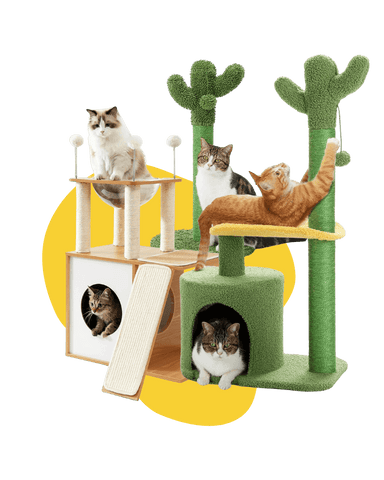
Cat trees, also known as cat towers or cat condos, have become increasingly popular among cat owners seeking to enhance their feline companions' indoor environment. These structures, ranging from small cat trees suitable for compact spaces to towering cat trees designed for large cats, offer a myriad of benefits that cater to the natural instincts and needs of domestic cats.
One of the primary advantages of cat trees is their ability to provide vertical space for cats. In the wild, cats are skilled climbers and jumpers, and cat trees simulate this natural behavior effectively. With platforms positioned at various heights and connected by ramps or scratching posts, these structures allow cats to exercise their muscles and practice agility in a safe and controlled indoor environment. This physical activity is crucial for maintaining a healthy weight and promoting overall well-being, particularly for indoor cats that may lack opportunities for outdoor exploration.
Furthermore, cat trees serve as essential enrichment tools. They offer cats opportunities for mental stimulation through exploration and play. Features such as hammocks, cozy perches, and dangling toys provide entertainment and comfort, encouraging cats to engage in activities that alleviate boredom and reduce stress. For multi-cat households, larger cat trees with multiple levels create space for social interaction and territorial fulfillment, supporting harmonious relationships among furry companions.
The design diversity of cat trees also contributes to their appeal. Modern cat trees with sleek lines and contemporary materials blend seamlessly with home decor, ensuring they complement living spaces aesthetically. Meanwhile, cat trees crafted from natural wood or adorned with plush fabric appeal to different tastes, offering options that cater to both practicality and style preferences.
Cat trees are not just furniture; they serve as functional elements within a home dedicated to feline comfort. Features like scratching posts integrated into the structure provide cats with appropriate outlets for their instinctive need to scratch, thereby preserving household furnishings from damage. Moreover, cat trees with built-in hideaways or enclosed spaces offer shy or anxious cats secluded retreats where they can observe their surroundings safely.

Choosing the right cat tree involves considering factors such as size, stability, and material quality. For larger or heavier cats, opting for a sturdy cat tree with a broad base and robust construction ensures safety and durability. Conversely, smaller cat trees are ideal for compact living spaces or households with limited floor area.
In conclusion, cat trees represent more than mere accessories for pampered pets; they are essential components of a cat-friendly home environment. From providing physical exercise and mental stimulation to offering comfort and security, these versatile structures cater to the innate instincts and diverse preferences of domestic cats. Whether it's a pretty cat tree designed to blend seamlessly with contemporary decor or a spacious cat tree house offering multiple levels of exploration, these furnishings enrich the lives of cats and their owners alike.
Incorporating a cat tree into your home is not just a good idea—it's a thoughtful investment in your cat's happiness and well-being, ensuring they lead fulfilling lives indoors.







